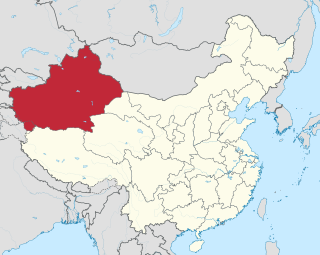
East Turkestan or East Turkistan, also called Uyghuristan, is a loosely-defined geographical region in the northwestern part of the People's Republic of China, which varies in meaning by context and usage. The term was coined in the 19th century by Russian Turkologists, including Nikita Bichurin, who intended the name to replace the common Western term for the region, "Chinese Turkestan", which referred to the Tarim Basin in Southern Xinjiang or Xinjiang as a whole during the Qing dynasty. Beginning in the 17th century, Altishahr, which means "Six Cities" in Uyghur, became the Uyghur name for the Tarim Basin. Uyghurs also called the Tarim Basin "Yettishar," which means "Seven Cities," and even "Sekkizshahr", which means "Eight Cities" in Uyghur. Chinese dynasties from the Han dynasty to the Tang dynasty had called an overlapping area the "Western Regions".

The East Turkestan independence movement is a political movement that seeks the independence of East Turkestan, a large and sparsely-populated region in northwest China, as a nation state for the Uyghur people. The region is currently administered by the People's Republic of China (PRC) in the Xinjiang Uygur Autonomous Region (XUAR). Within the movement, there is widespread support for the region to be renamed, since "Xinjiang" is seen by independence activists as a colonial name. "East Turkestan" is the best-known proposed name as it is the historical geographic name of the region and the name of the two independent states that briefly existed in the region in the first half of the 20th century.

The East Turkestan Liberation Organization (ETLO) was a secessionist Uyghur organization that advocated for an independent Uyghur state named East Turkestan in the Western Chinese province known as Xinjiang. The organization was established in Turkey in late 1997 to fight against the Chinese government in Xinjiang, a territory of ethnic Uyghur majority.
Ahmed Adil is a citizen of China who was held in extrajudicial detention in the United States Guantanamo Bay detainment camps in Cuba.
Ahmad Tourson or Ahmad Abdulahad, is a Uyghur refugee unlawfully detained for more than seven years in the United States Guantanamo Bay detainment camps. The detention occurred despite becoming clear early on that he was innocent. The Department of Defense reports that Tourson was born on January 26, 1971, in Xinjiang Province, China, and assigned him the Internment Serial Number 201. Tourson is one of approximately two dozen detainees from the Uighur ethnic group.

Hasan Mahsum, also known as Abu-Muhammad al-Turkestani and Ashan Sumut, was an Uyghur militant who was the leader of the Turkistan Islamic Party, an Islamic extremist group suspected of having ties with Al Qaeda. He was shot dead in a counter-terrorism operation on October 2, 2003 by the Pakistani Army.

The January 2007 Xinjiang raid was carried out on January 5, 2007, by Chinese paramilitary police against a suspected East Turkestan Islamic Movement (ETIM) training camp in Akto County in the Pamir plateau.
Terrorism in China refers to the use of terrorism to cause a political or ideological change in the People's Republic of China. The definition of terrorism differs among scholars, between international and national bodies and across time and there is no legally binding definition internationally. In the cultural setting of China, the term is relatively new and ambiguous.

The Islamic Jihad Union is a militant Islamist organization founded in 2002 as a splinter group of the Islamic Movement of Uzbekistan (IMU). Headquartered in North Waziristan, a mountainous region of northwest Pakistan, bordering Afghanistan, the group has been affiliated with both Al-Qaeda and the Taliban.
Abdul Haq al-Turkistani is a Uyghur Islamic militant who leads the Turkistan Islamic Party. The United States Treasury reported he took over leadership of the organization in 2003, following the death of its previous leader, and took a seat on al-Qaeda's shura in 2005.

The 2011 Kashgar attacks were a series of knife and bomb attacks in Kashgar, Xinjiang, China on July 30 and 31, 2011. On July 30, two Uyghur men hijacked a truck, killed its driver, and drove into a crowd of pedestrians. They got out of the truck and stabbed six people to death and injured 27 others. One of the attackers was killed by the crowd; the other was brought into custody. On July 31, a chain of two explosions started a fire at a downtown restaurant. A group of armed Uyghur men killed two people inside of the restaurant and four people outside, injuring 15 other people. Police shot five suspects dead, detained four, and killed two others who initially escaped arrest.

The Xinjiang conflict, also known as the East Turkistan conflict, Uyghur–Chinese conflict or Sino-East Turkistan conflict, is an ethnic geopolitical conflict in what is now China's far-northwest autonomous region of Xinjiang, also known as East Turkistan. It is centred around the Uyghurs, a Turkic ethnic group who constitute a plurality of the region's population.
On 26 June 2013, rioting broke out in Shanshan County, in the autonomous region of Xinjiang, China. 35 people died in the riots, including 22 civilians, two police officers and eleven attackers.

Foreign fighters have fought on all four sides of the Syrian Civil War, as well both sides of the War in Iraq. In addition to Sunni foreign fighters, Shia fighters from several countries have joined pro-government militias in Syria, leftist militants have joined Kurdish forces, and other foreign fighters have joined jihadist organizations and private military contractors recruit globally. Estimates of the total number of foreign Sunnis who have fought for the Syrian rebels over the course of the conflict range from 5,000 to over 10,000, while foreign Shia fighters numbered around 10,000 or less in 2013 rising to between 15,000 and 25,000 in 2017.
On 28 October 2013, a car ran over pedestrians and crashed in Tiananmen Square, Beijing, China, in a terrorist suicide attack. Five people died in the incident; three inside the vehicle and two others nearby. Police identified the driver as Usmen Hasan and the two passengers as his wife, Gulkiz Gini, and his mother, Kuwanhan Reyim. Dozens of people were injured.
On the early morning of Wednesday, 30 July 2014, Juma Tahir, the imam of China's largest mosque, the Id Kah Mosque in northwestern Kashgar, was stabbed to death by three young male Uyghur extremists. Religious leaders across denominations condemned the attack.

The Turkistan Islamic Party in Syria is the Syrian branch of the Turkistan Islamic Party, an armed Uyghur Jihadist group with a presence in the Syrian Civil War. While the TIP has been active in Syria, the organization's core leadership is based in Afghanistan and Pakistan, with a presence in its home territory of China.

Abu Omar al-Turkistani was a high-ranking commander for several al-Qaeda-affiliated groups, such as the Islamic Jihad Union (IJU), the Al-Nusra Front and the Turkistan Islamic Party in Syria (TIP). Active as a militant since at least 2001, al-Turkistani fought in both the War in Afghanistan and the Syrian Civil War. By late 2016, he was considered to be "one of top ten leading 'jihadists' in Syria" and one of the "four most prominent leaders" of TIP. Shortly before his death, al-Turkistani helped to facilitate the merger of many Islamist rebel groups into Tahrir al-Sham. He was eventually killed by an American drone strike on 1 January 2017.

Foreign fighters in the Syrian civil war have come to Syria and joined all four sides in the war. In addition to Sunni foreign fighters arriving to defend the Islamic State of Iraq and the Levant or join the Syrian rebels, Shia fighters from several countries have joined pro-government militias in Syria, and leftists have become foreign fighters in the Syrian Democratic Forces.

The Islamic State – Khorasan Province (ISIS–K) is a regional branch of the Islamic State terrorist group active in South-Central Asia, primarily Afghanistan. ISIS–K seeks to destabilize and overthrow existing governments of the historic Khorasan region to establish an Islamic caliphate under its strict, fundamentalist Islamist rule.












